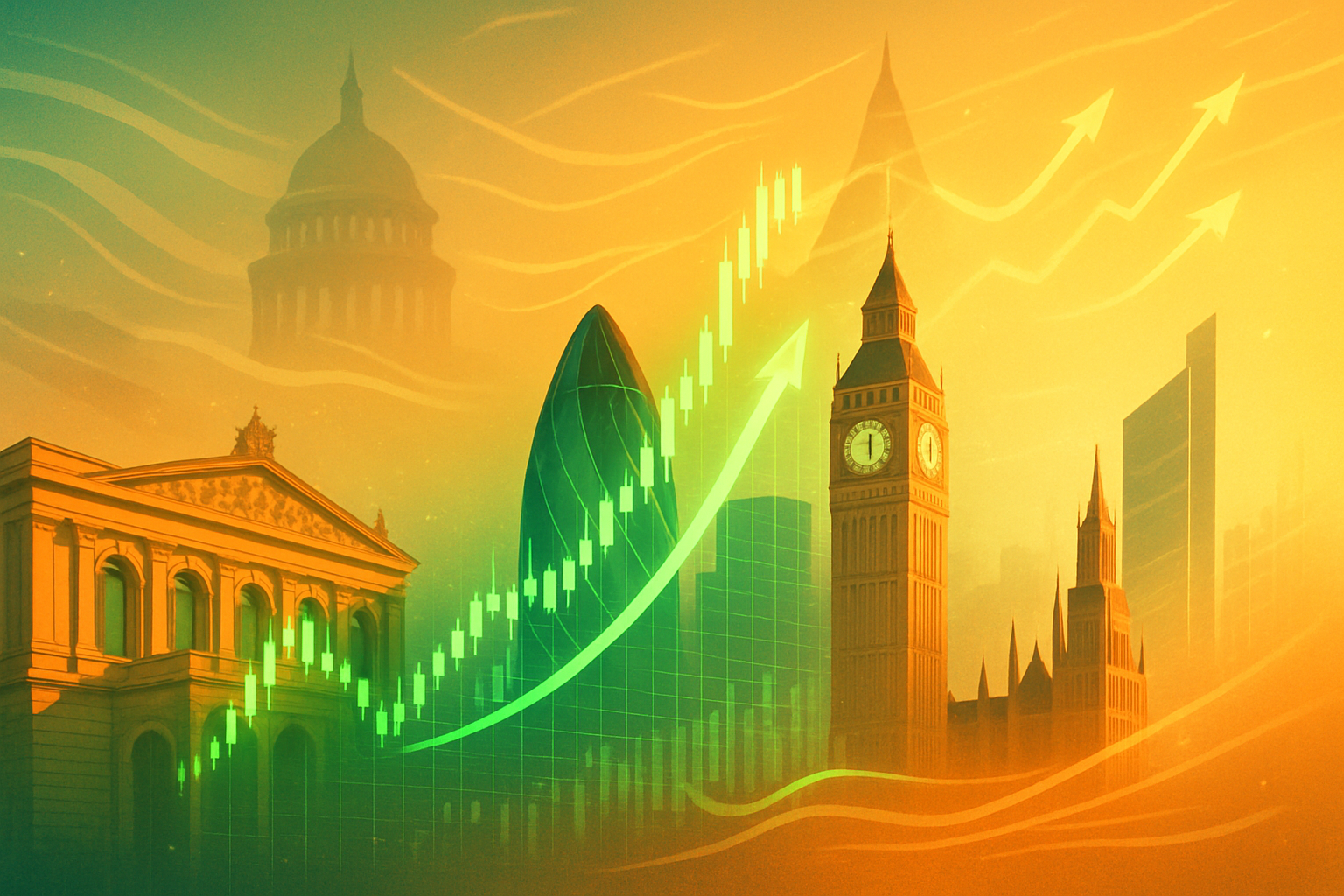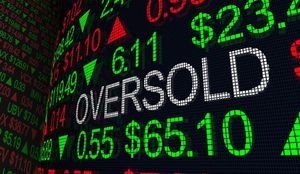
October 2, 2025 – European stock markets are currently experiencing an unprecedented surge, with key indices reaching or nearing all-time highs. This remarkable rally, observed across the continent, is largely attributed to a powerful combination of robust performance in the technology sector and burgeoning expectations for further interest rate cuts by the U.S. Federal Reserve. The anticipation of a more accommodative monetary policy from the world's most influential central bank has injected a significant dose of optimism into global financial markets, with European equities emerging as a prime beneficiary.
This bullish sentiment reflects a renewed confidence among investors, who are betting on reduced borrowing costs and a more liquid global financial environment. The interconnectedness of global markets means that even a policy shift in the United States can have profound ripple effects, making European assets more attractive and fueling a broad-based equity advance. As the Federal Reserve signals a "dovish pivot," European markets are responding with enthusiasm, recalibrating valuations and setting new benchmarks for growth.
The Fed's Dovish Turn and Europe's Ascent
As of early October 2025, European stock markets are displaying extraordinary buoyancy. The pan-European STOXX 600 index surged to a record high of 568.7 points on October 2, 2025, marking a year-to-date gain of over 11%. Similarly, the Euro Stoxx 50 index, tracking 50 blue-chip companies across the Euro Area, reached a record 5671 points on the same day, climbing 6.49% over the past month and up 15.23% year-over-year. Germany’s DAX index closed at 24,422.56 points, near its record high, while France’s CAC 40 index crossed the 8,000-point threshold, closing at 8056 points. The UK’s FTSE 100 index also touched another record high on October 2, 2025.
The primary catalyst for this rally is the Federal Reserve's recent monetary policy shift. In September 2025, the Fed initiated an easing cycle by cutting interest rates by 25 basis points (bp), bringing the federal funds rate to a range of 4.00%-4.25%. This was the first rate cut of the year, driven by concerns over a faltering U.S. labor market and a desire to stimulate hiring. Market participants are now widely anticipating further cuts, with the CME FedWatch Tool indicating a nearly 99% probability of another 25-bps reduction in October 2025, followed by another in December. J.P. Morgan Global Research and the Fed’s own projections foresee two more rate cuts by the end of 2025.
This "dovish pivot" by the Fed has several specific implications for European markets. Lower U.S. borrowing costs are generally seen as bullish for equities globally, enhancing corporate profitability, particularly for growth-oriented sectors. It also fosters a positive global investor sentiment, boosting confidence in the broader economic outlook. Furthermore, reduced U.S. interest rates tend to increase global liquidity, making assets in other markets, including European equities, more attractive. A weaker U.S. dollar, a consequence of lower rates, has also contributed to the Euro's appreciation against the dollar, reaching near a four-year high in September 2025. This divergence in monetary policy, with the European Central Bank (ECB) having completed its own rate-cutting cycle earlier and expected to maintain rates at 2% for the remainder of 2025, makes European equities relatively more appealing to international investors.
European Winners and Losers in a Dovish Fed Environment
The anticipated Federal Reserve rate cuts are creating distinct opportunities and challenges for European companies and sectors. The mechanisms of impact include changes in global borrowing costs, shifts in consumer spending patterns, altered export competitiveness due to currency fluctuations, and overall investor sentiment.
Likely Winners:
- Technology and Semiconductor Companies: This sector is a primary beneficiary, fueled by robust global demand for artificial intelligence (AI) infrastructure. European chip-related giants like ASML Holding N.V. (AMS: ASML) and ASM International N.V. (AMS: ASM) have seen substantial gains. STMicroelectronics (EPA: STM) is also noted as a beneficiary. Lower global borrowing costs support their R&D and expansion, while higher valuations reflect attractive future earnings in a booming tech landscape.
- Automotive Sector: Improved new car sales data globally, partly due to stimulated consumer spending from lower rates, are boosting this sector. Companies such as Stellantis N.V. (NYSE: STLA) and Ferrari N.V. (NYSE: RACE) have seen positive movement.
- Healthcare Stocks: This sector has extended gains, with companies like Sartorius (ETR: SRT) climbing after regulatory developments, such as a U.S.-Pfizer deal on prescription drug prices, reduced sector uncertainty.
- Industrials: Heavyweights like Siemens (ETR: SIE) and Schneider Electric (EPA: SU) have shown strong performance, benefiting from the prospects of softer monetary policy and potentially cheaper imported raw materials if the Euro strengthens.
- Luxury Goods: Companies such as LVMH Moët Hennessy Louis Vuitton (EPA: LVMH) and Kering S.A. (EPA: KER) often benefit from a weakening U.S. dollar, making European luxury products more attractive to international buyers.
- Real Estate: Directly benefits from the prospect of cheaper financing, making property investments more attractive and reducing the cost of debt for developers and homeowners.
- Importers and Eurozone Consumers: A stronger Euro, resulting from a weaker U.S. dollar, makes imports cheaper for European businesses and increases the purchasing power of Eurozone consumers.
Likely Losers (or those facing headwinds):
- European Exporters (general): A significantly stronger Euro against the U.S. dollar makes European exports more expensive for non-Eurozone buyers, potentially hurting their competitiveness and reducing demand.
- Financial Sector / Banks: While some banks are performing well, lower interest rates traditionally squeeze Net Interest Margins (NIMs), which can impact profitability, especially for banks with variable-rate loan portfolios.
- Traditional Industries and Less Innovative Companies: These firms face the risk of disruption from rapid advancements in technology and AI, potentially losing market share to more agile, tech-driven competitors, irrespective of monetary policy.
Broader Implications and Historical Parallels
The influence of Federal Reserve policy on global financial markets is a well-established phenomenon, and the current European rally is a testament to this interconnectedness. The U.S.'s role as a global financial hegemon means its monetary policy decisions have far-reaching implications, often setting the tone for investor sentiment and capital flows worldwide.
The current anticipation of Fed rate cuts has fostered a "risk-on" environment globally, boosting equity markets from New York to Tokyo. A key ripple effect is the weakening of the U.S. dollar, which can rebalance global trade by making U.S. exports more competitive and imports more expensive. Conversely, the strengthening Euro, approaching a four-year high, benefits Eurozone consumers and importers but can challenge European exporters. Lower U.S. interest rates also tend to attract capital into higher-yield markets globally, stimulating consumption and boosting asset prices, potentially benefiting emerging economies with dollar-denominated debt.
Broader industry trends are also at play. The European rally is significantly driven by a robust global surge in the technology sector, particularly in AI and semiconductors. This highlights the accelerating pace of digital transformation and the "AI arms race," which is creating a clear advantage for companies providing essential AI infrastructure and solutions. Beyond tech, the healthcare sector in Europe has also shown strong performance. The divergence in monetary policy between the Fed and the ECB, with the latter maintaining rates, is a significant factor reshaping currency dynamics and international capital flows.
Historically, Fed rate cuts in non-recessionary environments have often been followed by significant gains in European stocks, with an average increase of 8.3% after three months and 12.2% after six months. This aligns with the current scenario, where the Fed is cutting rates amidst concerns over a cooling labor market rather than a full-blown recession. Episodes like the "Volcker shock" of 1979-1982 or the Fed's interventions during the 2008 Global Financial Crisis underscore the central bank's critical role in global financial stability. The current U.S. government shutdown in October 2025 is adding political uncertainty, further intensifying expectations for Fed rate cuts and reinforcing the perception of the Fed as a key stabilizer.
The Road Ahead: Opportunities and Challenges
Looking ahead, the European markets are poised for a dynamic period, shaped by ongoing monetary policy shifts and evolving global economic conditions.
In the short-term, European markets are likely to continue benefiting from capital inflows as lower U.S. interest rates diminish the attractiveness of dollar-denominated assets. This will increase liquidity in Eurozone markets and potentially sustain the equity rally, particularly in interest-rate-sensitive sectors such as real estate, utilities, and small-cap stocks. The stronger Euro will benefit Eurozone importers and consumers through cheaper foreign goods. However, European companies, especially export-oriented ones, will need to strategically adapt to a stronger Euro by focusing on cost efficiencies, product differentiation, and non-price competitiveness.
For the long-term, Europe is forecasted to experience an economic upswing with moderating inflation and increased fiscal headroom, potentially leading to Eurozone GDP growth nearing U.S. levels as the U.S. economy is projected to slow in 2026. This could foster a diversified global tech ecosystem, with European companies playing increasingly vital roles. Strategic pivots for European companies will include deepening digital transformation and AI integration, strengthening supply chain resilience, and navigating the EU's stringent digital regulations. Investment opportunities will remain strong in technology, AI, and defense, while sectors like construction and energy can benefit from domestic stimulus packages.
However, challenges persist. A significantly stronger Euro could continue to pose headwinds for European multinational companies and export-oriented industries. Geopolitical risks and persistent global trade disputes introduce caution. There's also the risk of inflation remaining sticky, which could constrain central bank actions, and U.S. policy uncertainty could spill over into the Euro area. While European equities currently offer compelling valuations compared to U.S. markets, investors will need to monitor these factors closely.
Navigating the New Financial Landscape
The current rally in European stock markets, significantly propelled by the anticipated easing of Federal Reserve monetary policy, marks a pivotal moment in global finance. The key takeaway is the profound interconnectedness of global markets, where policy decisions in one major economy can create substantial ripple effects across continents. The "dovish pivot" by the Fed has not only instilled confidence but also reshaped capital flows, making European assets more attractive.
Moving forward, the market will be characterized by both significant opportunities and nuanced challenges. Investors should recognize the potential for continued growth in European equities, particularly in technology, industrials, and defense sectors, which are benefiting from global trends and lower borrowing costs. The relative undervaluation of European stocks compared to their U.S. counterparts also presents a compelling case for investment. However, the appreciating Euro poses a dual impact, benefiting importers and consumers but challenging exporters.
What investors should watch for in the coming months includes the actual pace and magnitude of further Fed rate cuts, any shifts in the ECB's monetary policy stance, and the evolution of global inflation. The ongoing U.S. government shutdown and broader geopolitical developments will also continue to influence market sentiment. European companies will need to remain agile, focusing on innovation, digital transformation, and strategic market positioning to capitalize on this evolving landscape. The current environment underscores the importance of a diversified portfolio and a keen eye on macro-economic indicators, as the global financial stage continues its intricate dance.
This content is intended for informational purposes only and is not financial advice.






